Heritage Tourism in Ghana
In activity two of this module we studied the history of Ghana from the pre-colonial era to the period after independence. We learnt about the European settlement in forts and castles along the coastal area and how one after the other all of the European powers left except the British who after 1874 became the only European group remaining in the Gold Coast. We have also learned about the slave trade which saw many Africans from this area deported from the continent and shipped via the Middle Passage to the Americas where they and their descendants were enslaved until slavery was abolished in the 19th century. The activity explained how these forts and castles played an important role in the slave trade.
These historical sites along with natural eco-tourism sites make Ghana one of the favorite African destinations for tourists coming from Europe and North America, including many who are part of the African Diaspora in the Americas and in Europe. Activity 4 will discuss tourism in Ghana with an emphasis on cultural heritage tourism. Tourism is an important source of revenue for the country. In recent decades it has been the third largest source of national revenue, surpassed only by gold and cocoa.
Many of you know about tourism; you know what a tourist is, and maybe you have even been a tourist yourself, either to another part of the U.S. or to another country. However, you may not be familiar with the notion of cultural or heritage tourism. That is why before studying heritage tourism in Ghana, this activity will address three main questions about tourism and heritage tourism:
- What is tourism?
- What is heritage tourism?
- What distinguishes a heritage tourism site?
What is heritage tourism?
Tourism is generally defined as the activity or practice of touring, especially for pleasure. It is also the business or industry of providing information, accommodation, transportation, and other services to tourists. In our study of tourism in Ghana, both aspects of this definition will be considered; that is the practice and the business of tourism. In addition to providing numerous wonderful natural sites for tourists to enjoy, Ghana presents other advantages for both Africans living in the Diaspora and for Europeans and North Americans in quest of knowledge about slavery or the colonial past of the county. These groups of travelers are quite often referred to as heritage tourists.
Cultural heritage tourism or heritage tourism is “traveling to experience the places, artifacts and activities that authentically represent the stories and people of the past and present.” (National Trust for Historic Preservation). It can be conceived as traveling with the objective of experiencing the arts, heritage and special cultural character of a place. This is what some refer to it as the feel good tourism or experienced-based travel.
Who are cultural heritage tourists?
Building on the previous definition, a tourist is anyone who is traveling for his or her pleasure. Within this larger category of travelers is a smaller group identified as heritage tourists. These tourists are either looking for a peculiar experience linked with their past or ethnic identity or they are searching for particular information. These tourists tend to be older than the average tourist and often times they have higher levels of education than the average population. Heritage tourists are usually interested in quality and authenticity and prefer traveling in small groups.
What characterizes a heritage site?
Tourist attractions or tourist sites range from artificial human made structures to natural wonders. A heritage site is usually a preexisting site, not constructed or created specifically for the purpose of attracting tourists. Quite often a heritage site is part of the history and the culture of a specific group of people. For these considerations, heritage sites are irreplaceable as they are important assets in understanding the history and the culture of a particular group of people. Heritage sites are very useful for the cultural, educational, social, and economic benefits they provide not only to present but also future generations.
Heritage sites, because of their antiquity, need careful up-keep and on-going renovation. Local, national and international resources are often used in the restoration and up-keep of the sites. Any site that presents a particular interest for its architecture or its history can become a heritage site. Other factors may include the scientific value, environmental, or archeological value of a sight. All in all, the reasons for preservation are various and depend on how a particular community or country views its identity or interpret its past.
Your Turn: Identifying sites
Read the following list of tourist sites and then choose two on the list and Google each to find out information about them. After you have read that information indicate if they are heritage tour sites or just regular tour sites.
- Disney Land
- A Theme park
- Las Vegas
- Yellowstone
- Jamestown/Williamsburg Virginia
- Knott’s Berry Farm
- Death Valley National Park
- Yosemite National Park
- Valley Forge Park
- The Sleeping Bears Dunes
- The Grand Canyon
We have learned that a tourist travels for his pleasure and that a heritage tourist chooses a destination for reasons other than mere pleasure. We have also learned that any site that presents a special character or interest can become a heritage site. In the second part of this activity we are going to study heritage tourism in Ghana and we will learn why Ghana is considered a place of special interest for heritage tourism.
Heritage tourism in Ghana
In this section we will study how and why the government got involved in the business of tourism, the importance of Ghana for heritage tourism, heritage sites in Ghana, and finally we will analyze what tourists experience on those sites.
The promotion of heritage tourism in Ghana is part of a national effort launched in 1985 by officials to develop the economy of the country. In fulfillment of that agenda the government started a program of restoration, preservation and promotion of the cultural, historical and natural resources of country. Many sites have been selected for restoration. These sites usually are of historical and cultural significance not only for the Ghanaians but also for the African Diaspora in the Americas and Europe. The cultural-historical sites include castles and forts built centuries ago to facilitate the slave trade or during colonization.
The cultural and historical assets presented by these sites, officially recognized by UNESCO (United Nations Educational Scientific and Cultural Organization) as world heritage sites, encouraged many institutions, foreign and national, to contribute to the project of preservation. These institutions include the Ghana Museum and Monuments Board, the U.S. Agency for International Development, the United Nations Development Program, and Shell Oil (Ghana) Limited. However, Ghana is not the only African country that experienced slavery and colonization. Neither is it the only West African country to have forts or castles that facilitated the slave trade. So why is that it one of the few countries in West Africa to generate and attract heritage tourism?
Why is Ghana an important destination?
The importance of Ghana as a heritage tourist destination comes from the slave trade and colonization. From Activity II of this unit and from Module 7B: African History, the Era of Global Encroachment, we have learned about the horrors of slave trade and its tremendously negative impact on the subsequent history of West Africa. The slave trade brought millions of Africans into bondage in the Americas, and broke their link with the African continent for centuries. The descendants of the slaves are now considered the African Diaspora.
Before departing to the Americas, slaves who had been captured in the interior were held in dark and crowed dungeons in colonial forts and castles along the Atlantic coast. Studies show that Ghana, with nearly 80 castles and colonial structures on about 300 miles of Atlantic Ocean shoreline, comprises almost two thirds of all the castles and forts slave traders and colonizers built on the West African coast. The reason why explorers preferred Ghana—or the Gold Coast as they called the area before it became independent– is still not fully explained. Some historians believe that the Ghanaian coastal kingdoms were more open to trading with Europeans and hence facilitated the implementation of the slave trade and the settlement of the Europeans along their coast.
The African Diaspora
The African Diaspora is made up of the descendants of Africans in the United States, Canada, the Caribbean, Latin America, in Europe, and in parts of western and southern Asia. For the Diaspora community, Africa is regarded as the ancestral homeland, so traveling to Africa is a voyage of rediscovery of their cultural roots, the place from where their ancestors were captured, enslaved and shipped to the New World. It is with excitement, sorrow, and curiosity that the Diaspora returns to Africa to discover and experience life in the motherland. But, Africa is a vast continent. A trip to Africa without a specific destination may not have the same meaning as a trip made to a destination laden with artifacts and sites that are reminiscent of the experience of their ancestors. For these reasons, the African Diaspora living in the Americas are likely to visit a country like Ghana.
Among West African countries, Ghana is one of the nations that still has many monument and castles of the slave trade era. In addition to these monuments, Ghana was the first sub-Saharan African colonialism to throw off the chains of colonialism (1957) and become an independent nation-state. This special status makes Ghana attractive to many prominent black intellectuals from the African Diaspora, some who served in the first post-independent government of President Kwame Nkrumah. Some of the Diaspora returnees permanently settled in the country and eventually created an important and vibrant African American community in Ghana. Among these intellectuals were people like George Padmore from the Caribbean and W.E.B. Du Bois a black intellectual from the United States.


Heritage sites in Ghana
Heritage tourism is most closely associated with slave trade structures in Ghana consisting of old colonial houses, the forts and castles built by the early European traders. These forts served different purposes. They were built for trade, commerce, administrative, or military rule. However, the most remembered function is the role they played during the era of the trans-Atlantic slave trade. These forts served as a place where slaves were sold and imprisoned before being shipped to the Americas. They were put in small rooms for weeks or sometimes months before their departure.
In addition, these forts served different purposes under different conditions. They helped protect the one European power against rival Europeans who also wanted to benefit from the slave trade. They also served as prisons which prevented slaves from escaping, and finally they helped Europeans defend themselves against local population.
In the following section we will study a few of the many sites tourists are generally interested in while visiting Ghana.
Elmina Castle
Elmina was built by the Portuguese in 1482 but taken over by the Dutch in 1637 for 274 years. Apart from being the first European trading fort in tropical Africa, the fort also shelters one of the earliest Catholic Church in Sub-Sahara Africa. It served during the slave trade as a place where slaves were held in dark dungeons without light before being shipped to the new world. Because of its importance, Elmina was selected along with the Osu castle in Accra by the United Nations Educational Science and Communication Organization (UNESCO) as World Heritage Monuments.



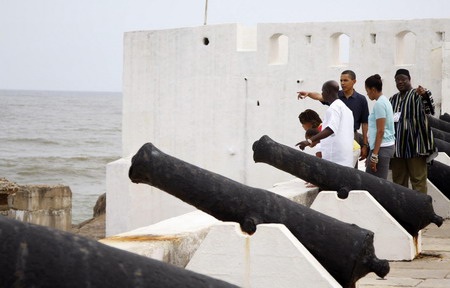

Christianborg castle

Christianborg Castle, also called the Osu castle, in Accra (the capital city), has served as Ghana’s seat of government since 1876. It has housed the executive since 1960 when Kwame Nkrumah declared Ghana a Republic. New rooms were added to the castle in 1961 to accommodate the Queen of England Elizabeth.
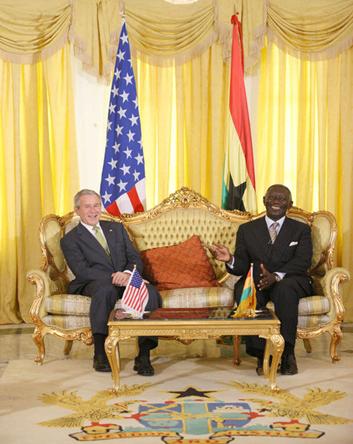

However, there are moral issues surrounding the castle. It became a matter of controversy in 2005 as to whether the government should relocate or retain the Castle as the seat of government. These questions were raised by critics who asserted that an old castle that kept slaves should not be used as the seat of the government of an independent African nation. In November 2008, a new government seat was inaugurated by the former President John Kufuor’s administration, the Golden Jubilee Palace. But his successor, John Atta Mills refuses to use this as the seat for its government and instead continues to use Osu Castle.

Osu Castle has been visited by many international leaders. Among the famous visitor of the castle are Richard Nixon (the first U.S. president to visit a sub-Saharan African country), Bill Clinton, George Bush and Barack Obama. The castle also offers other facilities like a shopping center, a clinic, a post-office and a café. There is also a permanent garrison stationed at Osu Castle. It has a beautiful garden that extends over quite a large area. This garden houses both imported plants and a local variety of plants which are taken care of by a staff of 30 people. As it could be expected, since it is the seat of government, tourists are not allowed to enter the Osu Castle. However they can still make it a point to at least catch a glimpse of it while they pass by.
Your Turn:
Many of you grow up knowing that the White House is the official seat of the Executive branch of the United States of America. It is both the office and the residence of the President of the United States. Imagine you learn a different history about the White House, in which the White house served in the past as a place where Slaves were kept upon their arrival in the U.S. What ethical problems do you think these details about the White House would pose today? How would you react to it if it still continued to be the seat of the government?
Cape Coast castle
It was first built in 16th century as a small trading lodge, but later it was enlarged into a Fort in 1627 by the Dutch. Cape Coast castle was later captured by the Swedish who made it a castle for the Swedish African Company and named it Carolusberg in 1653. Finally, in 1664 the British took possession of the Castle and turned it into the seat of the colonial administration until 1877 the year they moved to the Osu castle in Accra.

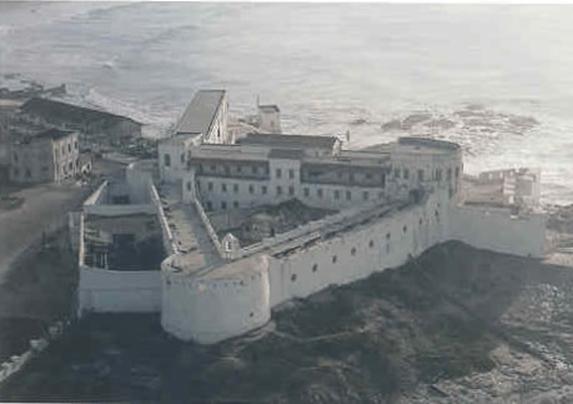
You can access more information and visual on the Coast Castle website:
http://www.ghanamuseums.org/monuments.php
Kwame Nkrumah Memorial Park
You will recall that activity two of this module covered the history of Ghana. We learned about Kwame Nkrumah, a Pan-Africanist who led the country to independence in 1957. Nkrumah is considered the “founding father” of independent Ghana, and he is highly regarded throughout the continent of Africa as a hero of Africa’s struggle both against colonialism and for a unified Africa. He governed Ghana between 1957 and 1966. Nkrumah’s reign was abruptly brought to an end on February 24th, 1966 by a military coup. He was forced to exile in Guinea-Conakry where he was buried in 1972, following his death in Bucharest (Rumania) where he was undergoing medical treatment.
His image and legacy, controversial at first, were slowly restored by his successors. Kwame Nkrumah was buried twice before being brought to his current resting in the Memorial Park in Accra. After the coup, Nkrumah was declared co-president of Guinea with Sekou Toure where he was in exile. So after his death he was buried at Conakry, Guinea in the Camayeen Mausoleum.
On July 1st, 1992 the Ghanaian government commissioned a monument to restore his image. The location chosen was the very place where the declaration speech of independence was made,a place that used be called the Old Polo Grounds.

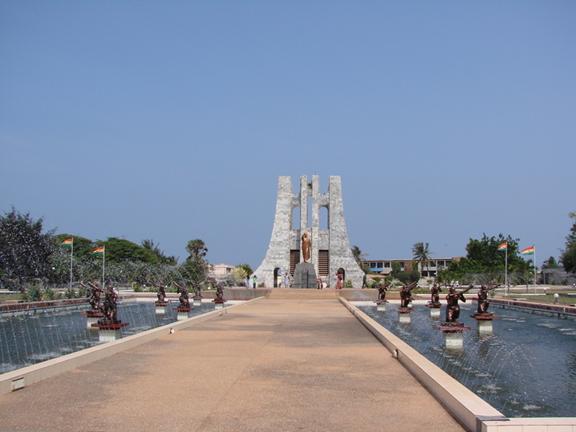

The Du Bois center also has a mausoleum, a personal library, and a museum of that celebrates the rich life of D.r Du Bois. It serves as a tourist site and hosts several activities like lectures, seminars and exhibitions that attract people from across Africa and from the Diaspora.
Du Bois Center in Accra
Like the Nkrumah memorial park, Accra also hosts the Du Bois Center, which is the resting place for the late Dr. W.E.B. Du Bois and his wife Shirley Graham Du Bois. Its full name is the W.E.B. Du Bois Memorial Centre for Pan-African Culture. The center was created in 1985 to serve as a research institution for Pan-African history and culture and the intellectual legacy of Du Bois. The Center is considered a national historic monument and as such is put under the direct administration of the Ministry of Chieftaincy and Culture.
http://webduboiscentreaccra.ghana-net.com




Your Turn
- Who was Dr. Du Bois? Do some research on the life and the works of Dr. W.E.B Du Bois and briefly summarize and share with your classmate what you have learnt about him.
- What was his connection with Ghana?
- Do you think a center named after him presents any importance for heritage tourism? Why?
- Do an online search of Du Bois in Ghana. Who are some of the other intellectuals from the African Diaspora with whom Du Bois interacted? What were the primary reasons for his decision to retire in Ghana?
Who visit these sites?
Tourists come from all over the world to visit these historical sites. They come from North America, South America, Europe, and the Caribbean and from other countries in Africa. The majority of these tourists are Africans from the Diaspora. The African Diaspora refers to the descendants of the Africans slaves that were shipped to the Americas from the 15th century until the abolition the triangular trade in the early 19th century. During the centuries that they lived in the Americas the diaspora, for the most part, has lost touch with their African cultures and traditions. You are probably too young to remember the movie “Roots” that tells the story of Kunta Kinte, the ancestor of the famous writer Alex Haley. His story traced the roots of Haley back to the present day Gambia. Ever since that story was published and then made into a made for TV movie series, West Africa has become a place that many African-Americans travel to in search of their own roots. On a larger scale, Africa is the continent of their cultural and racial heritage to many among these Africans from the Diaspora.
The importance of Africa to the African Diasporas and the African Americans is shown through the praise and reference to the continent in books, songs and poetry and movies. Whether they are American writers or movie producers or Caribbean singers, Africa is the land of the ancestors and a great source of pride. Past African kings, military excellence and economic prowess is recalled and cited as heritage and considered a source of pride for the African Diaspora.
But it is not only people from the Diaspora who visit Ghana and its historical sites. European Tourists who are interested in seeing the marks that slavery and colonialism left also visit Ghana.
Experiencing the past on the sites
We learnt that heritage tourists visiting Ghana usually go to Elmina, Cape Coast and other sites in the interior of the country (like the Akossombo Dam or the Kakum National Park). People may visit the same sites but their emotion or impressions during and after the visit are not always the same. These feelings differ from one tourist to the other and according to the reasons for visiting the site.
The Castle of Elmina and Cape Coast are visited for their link with the colonial past and with slavery but others visit them for their architecture and their location.
At Elmina general highlights of the experience are:
- The Door of No Return
- The slave dungeon (male and female)
Tourist visiting these sites alone may rely on the signs on each part or cell of the castle to find their way. Visitors in groups are often given special tours and performances, such as the passage through “The Door of No Return—The Return” and the cells where slave were incarcerated or kept while waiting for their time to board the ships for the New World.
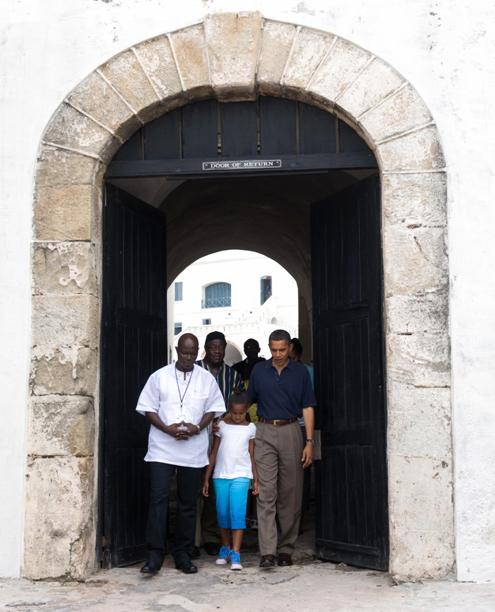


Visitors to Elmina and Osu usually have different opinions and impressions when visiting these sites. But regardless of their differences, they all share the ideas summarized in the inscription on the wall in Elmina (above). It states that the crime committed against humanity should not be forgotten and never should it be repeated again. Some are outraged while others are sad. But other people are more interested in the architecture and downplay the memory of horrors that may transpire through their experience.
Here are the excerpts of the reactions of two visitors to Elmina:
- “Nowhere has a place touched me more than Elmina Castle. The walls of the fortress exude a cooling sadness, as if the ghosts of those who had died within those walls are still wandering the grounds, wondering when they would be returned their freedom.” http://www.bootsnall.com/articles/07-05/remembering-elmina-ghana-africa.html
- “The deepest sense of irony becomes clear when we consider the way in which the monuments are packaged and marketed for global tourism, especially for cultural heritage tourism. Here, the thing that is being sold (back) to the tourist is the memory of their ancestors: the now-absent black bodies that become part of the allure of these monuments. It is an irony some visitors to the castles have complained about. As one person put it, “Don’t turn our memories into a tourist attraction.” In the current age of global tourism, memory itself becomes a commodity–a thing to be bought, sold, and traded.” http://www.common-place.org/vol-01/no-04/finley/finley-4.shtml
- Here is a comment by Roland Martin a famous CNN contributor: “It’s hard to fathom how such unbelievable brutality, and breathtaking beauty, could co-exist. After venturing out from Accra early this morning on a three-hour ride, we arrived in Elmina to tour the Elmina Slave Castle, initially built by the Portuguese. Our knowledgeable guide, Phillip, provided riveting, and often sad, testimony to the horrors of the Trans-Atlantic Slave Trade, showing us the places where women were separated from men; a spot where a woman who refused to be raped by her captors was held in a ball and chain with no food until she submitted; and the holding cell where male slaves were sent to be broken of their will. And of course, nothing signifies the finality of the slaves the “Door of No Return,” the sliver in a stone wall or an actual door where African slaves had to crouch low to the ground as they were ushered through one by one, checked off on a sheet of paper like cattle, never to see the Motherland again.” http://ac360.blogs.cnn.com/2008/07/23/ghanian-slave-castles-where-beauty-and-brutality-co-exist/
Your Turn:
Answer the following questions:
- Give an example of heritage tourism sites
- Have you ever visited a heritage tourism site?
- What did you see there?
- How did you feel? What impression did you have before and after visiting the site?
- How did the tour affect you? Positively? Negatively?
- What did you learn about your own heritage?
- How does a heritage site shape the perception for the past?
- How much of the past can be remembered at a cultural heritage site? What is lost and how does it affect our sense of history?
a. Heritage tourism is more about the past and about memory. It raises many questions about what we remember and how we remember it. What do you feel should be essentially remembered when visiting the Castles in Ghana?
b. As part of its policy to develop the tourism industry, the Ghanaian government has included a plan to renovate some of the sites. Some visitors of the sites are against the renovation of sites and argue that it should be left to ruin and destruction by the sea. The second tourist for example complains about the fact that the memory experienced on the site was being commoditized into a tourist attraction and consequently threatened to be devoid of the sentimental value that the site is supposed to bring to the visitor. Read the reaction again and if you like, follow the link and read the webpage. In a paragraph or two, write down your reactions to that complaint and argue whether it is a just complaint or whether a heritage site should (not) be transformed or renovated to welcome the flow of tourists and why.
***
http://www.ghanaexpeditions.com/regions/region_detail.asp?sec=GETHERE
http://www.common-place.org/vol-01/no-04/finley/index.shtml
This is the final activity in this module. Return to the curriculum, go on to Module Twenty Five, or select from one of the other activities in this module.
